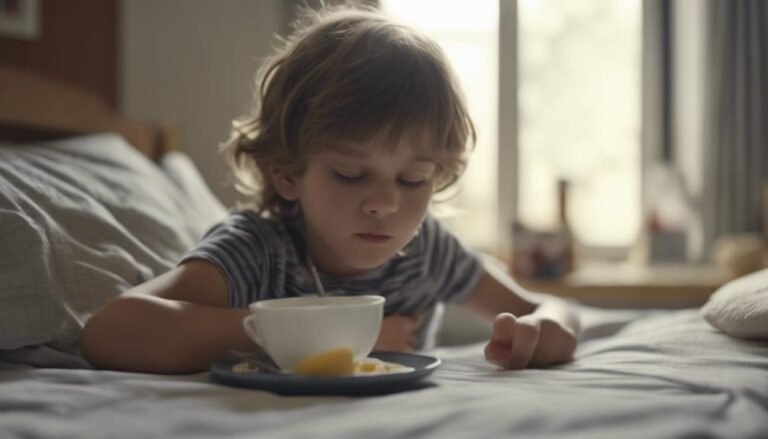Creative Arts and Crafts Projects for Enhancing Fine Motor Skills
Exploring to improve fine motor skills in a creative way? Ever wondered how arts and crafts projects could be the key to honing those abilities?
Immerse yourself in a world where creativity meets skill development through various hands-on activities. From intricate painting techniques to detailed jewelry making, each project offers a unique opportunity to refine those delicate movements.
Explore a range of crafts that not only spark your creativity but also work wonders in enhancing your fine motor skills.
Key Takeaways
- Painting techniques and clay modeling improve dexterity and concentration.
- Crafting projects like woodworking and knitting enhance precision and creativity.
- String art and sewing techniques boost focus and hand-eye coordination.
- Therapeutic art activities such as origami and jewelry making promote relaxation and mindfulness.
Painting Techniques for Fine Motor Skills
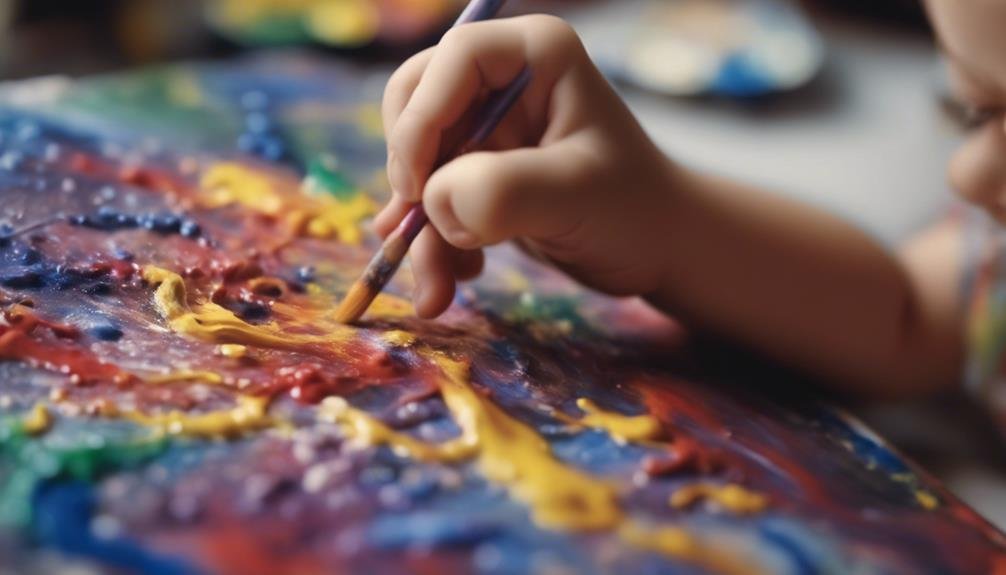
To enhance fine motor skills through painting, focus on utilizing various brush strokes and hand movements to promote dexterity and precision. Experiment with different brush strokes like broad washes, controlled lines, and intricate details to improve control and coordination. Practice color blending by mixing primary colors to create secondary tones, enhancing visual perception and creativity.
Texture creation is another crucial aspect of painting for fine motor skills development. Encourage tactile exploration by incorporating various materials like sand, salt, or even sugar into your paint to create textured surfaces. Layering techniques involving building up colors and shapes can enhance hand-eye coordination and spatial awareness.
Engaging in these painting techniques not only enhances fine motor skills but also provides a therapeutic outlet for self-expression and creativity. Through the process of painting, individuals can improve focus, reduce stress, and boost self-esteem. Embrace the journey of exploring different brush strokes and textures to reveal the full potential of your fine motor skills.
Clay Modeling and Pottery
Enhance your fine motor skills through the tactile and essential art of clay modeling and pottery, allowing for hands-on exploration and creativity. Sculpting techniques involve molding clay into various shapes using your hands or tools like carving tools and wire loops. Hand building methods such as pinch pots, coil pots, and slab construction offer a more structured approach to creating pottery. These techniques not only enhance fine motor skills but also promote relaxation and focus.
Once you have sculpted or built your clay creation, the firing process is vital for hardening the piece. Firing can be done in a kiln or using alternative methods like pit firing. Glazing options provide the opportunity to add color and texture to your pottery. Experimenting with different glazes and techniques like dipping, pouring, or brushing can further develop your fine motor skills while allowing for artistic expression.
Clay modeling and pottery aren't only enjoyable hobbies but also therapeutic activities that can improve hand-eye coordination and concentration.
Origami and Paper Folding
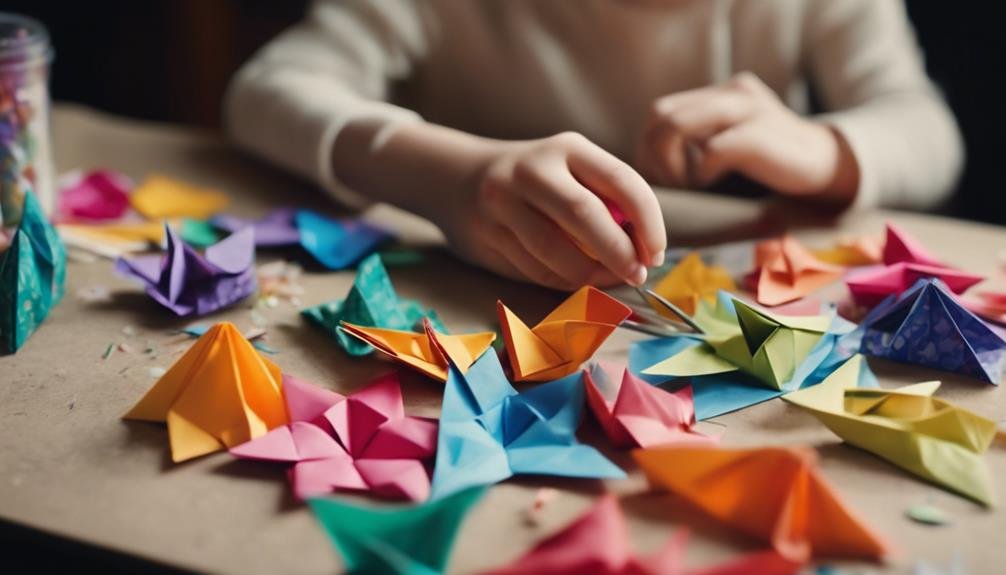
Immerse yourself in the art of origami and paper folding to develop intricate fine motor skills and engage in a mindful, creative activity. Origami, the Japanese art of paper folding, offers a therapeutic and rewarding experience. Through the precise and delicate nature of folding paper, you can enhance your motor skills while creating stunning paper sculptures.
| Advantages of Origami | Examples of Designs |
|---|---|
| Enhances fine motor skills | Animals, flowers |
| Boosts concentration levels | Modular origami |
| Develops patience | Geometric shapes |
| Encourages creativity | Origami tessellations |
| Relieves stress | 3D origami structures |
Engaging in advanced origami allows you to explore intricate designs that challenge your dexterity and focus. The combination of creativity and precision folding in origami not only results in beautiful creations but also provides a calming and meditative experience. So, grab a piece of paper, follow some instructions, and let your hands craft wonders through the art of origami.
String Art and Thread Painting
Explore the intricate art forms of string art and thread painting to enhance your fine motor skills and engage in a therapeutic and creative activity.
Using colorful yarns with precision, string art involves creating stunning designs by wrapping threads around pegs or nails on a board. This process requires careful hand-eye coordination and precise movements to achieve beautiful geometric shapes and intricate designs. As you loop the threads around the pegs, your fingers will develop dexterity and strength, enhancing your fine motor skills.
Thread painting, on the other hand, involves using threads to create detailed images on fabric. By carefully stitching different colored threads onto a canvas, you can produce a wide range of textures and patterns. This activity demands focus and attention to detail, aiding in the development of your hand-eye coordination and fine motor skills. The rhythmic motion of stitching can also have a calming effect, making it a therapeutic way to express your creativity while improving your manual dexterity.
Try your hand at string art and thread painting to not only create beautiful artwork but also to enhance your fine motor skills in a relaxing and enjoyable manner.
Sewing and Embroidery Projects
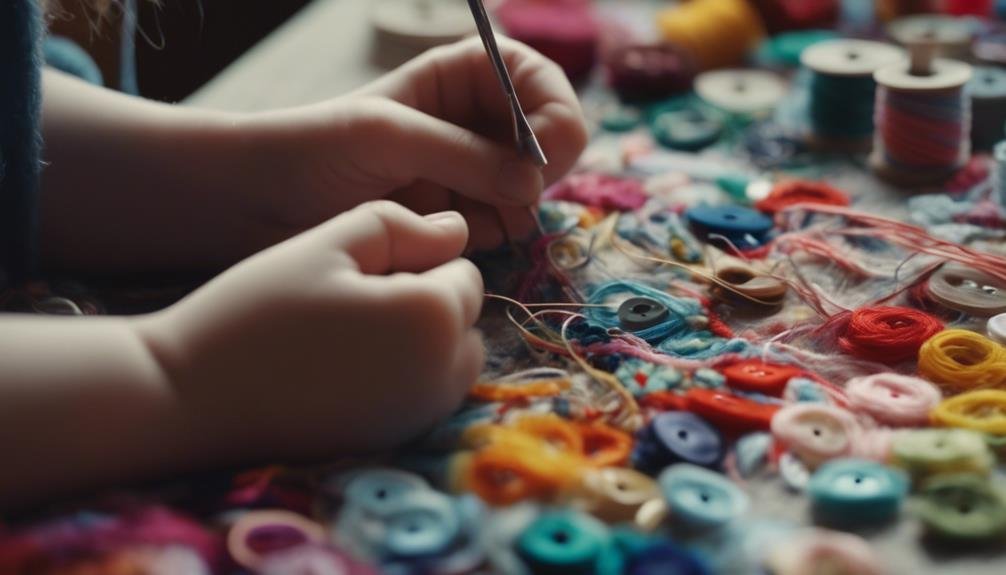
Engage in sewing and embroidery projects to refine your fine motor skills through intricate needlework and creative stitching techniques. Sewing and embroidery not only allow you to create beautiful pieces but also enhance your hand-eye coordination and concentration. By practicing different stitching patterns and mastering various needlework techniques, you can improve your dexterity and precision.
Below is a table highlighting some common stitching patterns and needlework techniques you can explore in your sewing and embroidery projects:
| Stitching Patterns | Needlework Techniques |
|---|---|
| Running Stitch | Satin Stitch |
| Backstitch | French Knot |
| Chain Stitch | Stem Stitch |
| Blanket Stitch | Lazy Daisy Stitch |
Experimenting with these stitching patterns and needlework techniques will not only boost your fine motor skills but also provide a therapeutic and calming effect. So, pick up your needle and thread, and start creating intricate designs that will enhance your motor skills and creativity simultaneously.
Beadwork and Jewelry Making
For sharpening your fine motor skills and discovering your creativity, delve into the world of beadwork and jewelry making with intricate designs and precise handiwork. Here are some tips to help you get started:
- Wire Wrapping Techniques
- Learn different wire wrapping methods like basic loops, coils, and spirals to create unique jewelry pieces.
- Experiment with different wire thicknesses and materials for varied effects.
- Practice precision and patience as you manipulate the wire into desired shapes.
- Color Mixing
- Explore color theory to create harmonious color palettes for your beadwork.
- Mix and match different bead colors to achieve the desired aesthetic.
- Pay attention to color combinations to evoke different emotions and moods in your jewelry pieces.
- Metal Stamping
- Invest in quality metal stamping tools for adding personalized touches to your jewelry.
- Practice on scrap metal pieces before stamping on the final jewelry item.
- Experiment with different fonts and designs to make each piece unique.
- Gemstone Selection
- Research the properties and meanings of different gemstones to incorporate symbolism into your jewelry.
- Choose high-quality gemstones for durability and aesthetic appeal.
- Consider the color, shape, and size of gemstones to complement your overall design.
Woodworking and Carpentry Crafts
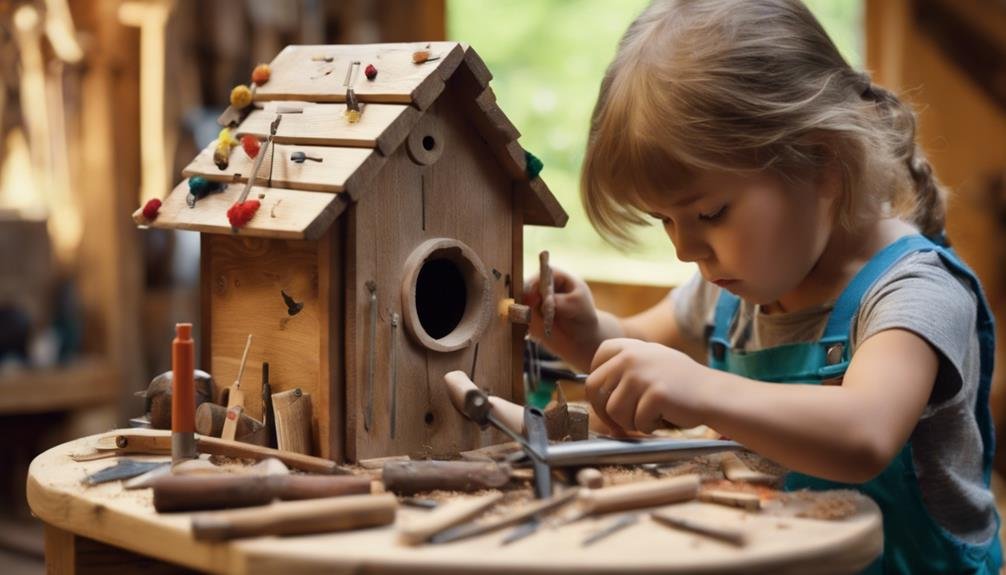
To further hone your fine motor skills and engage in hands-on craftsmanship, consider venturing into the domain of woodworking and carpentry crafts where precision and creativity converge in shaping wood into functional and artistic pieces. Woodworking allows you to work with various tools such as saws, drills, and sanders, enhancing dexterity and hand-eye coordination. When delving into furniture making, you'll learn to measure precisely, cut accurately, and assemble intricately, all of which are beneficial for fine motor skill development.
Wood staining is a vital aspect of woodworking that involves applying different stains to wood surfaces to enhance their appearance. This process requires a steady hand and attention to detail, fostering patience and control over movements. Additionally, furniture making involves intricate tasks like joining pieces together, sanding surfaces to smoothness, and finishing with precision, all of which contribute to refining your fine motor skills.
Engaging in woodworking and carpentry crafts not only provides a creative outlet but also offers a therapeutic experience as you immerse yourself in the process of transforming raw wood into beautiful and functional pieces through meticulous craftsmanship.
Knitting and Crocheting Patterns
Exploring intricate knitting and crocheting patterns can elevate your fine motor skills through detailed hand movements and creative stitch work. Engaging in yarn crafts and fiber arts offers a therapeutic and rewarding experience, enhancing your dexterity and cognitive abilities.
Here are some benefits of delving into knitting and crocheting patterns:
- Fine Motor Skills: The repetitive motions involved in knitting and crocheting can help improve hand-eye coordination and finger dexterity.
- Focus and Concentration: Following complex patterns requires focus, enhancing your ability to concentrate and pay attention to detail.
- Stress Reduction: The rhythmic movements of knitting and crocheting have been shown to reduce stress and promote relaxation.
- Creative Expression: Experimenting with different yarn colors and textures allows for creative expression and fosters a sense of accomplishment.
Mosaic Art and Tile Projects
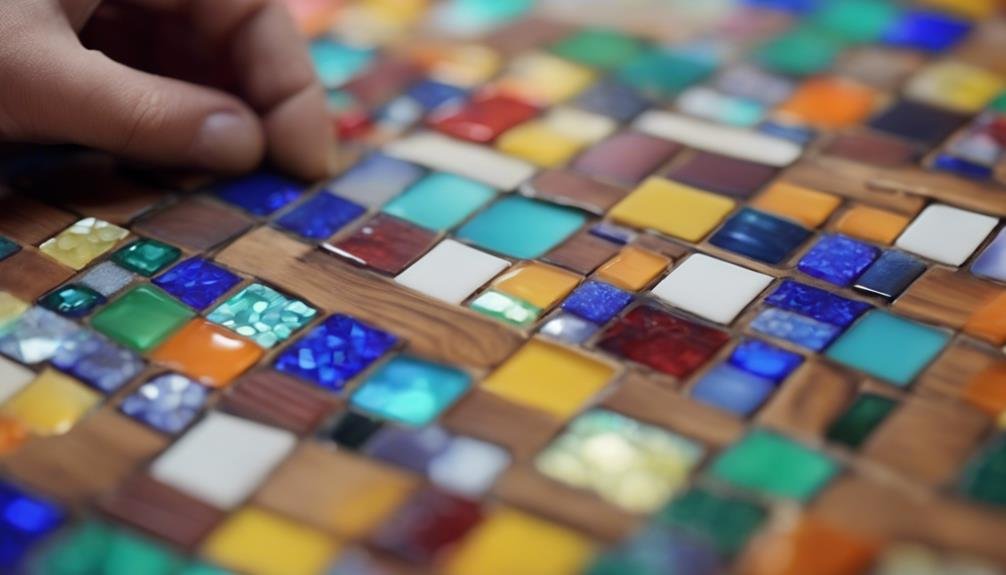
Enhancing your fine motor skills can also be achieved through engaging in Mosaic Art and Tile Projects, which offer a creative outlet for intricate hand movements and precise placement of materials. In glass tessellation, the delicate process of arranging small glass pieces to form a larger image can greatly improve your hand-eye coordination and dexterity. Experimenting with grout techniques adds another layer of skill development, requiring careful application and smoothing to complete the mosaic.
On the other hand, working with ceramic mosaics provides a hands-on experience in shaping and glazing methods. The intricate nature of ceramic pieces encourages attention to detail and patience, important elements for refining fine motor skills. Applying glazes to ceramic tiles not only enhances their aesthetic appeal but also hones your ability to control brush movements and achieve desired color outcomes.
Both glass and ceramic mosaic projects serve as therapeutic activities that engage your senses and promote mindfulness through the meticulous process of creating art. Experimenting with different materials and techniques in mosaic art can lead to a rewarding experience that enhances your fine motor skills while releasing your creativity.
Frequently Asked Questions
What Are Some Alternative Materials That Can Be Used for String Art and Thread Painting Projects?
For your string art and thread painting projects, consider using alternative materials like buttons for button art and paper strips for paper quilling. Explore yarn weaving for texture and fabric collage for depth. You'll enjoy the creative process!
How Can I Adapt Woodworking and Carpentry Crafts for Children With Special Needs?
To adapt woodworking and carpentry crafts for children with special needs, consider using adaptive techniques like modified tools and workstations. Encourage sensory exploration through tactile materials and visual aids. Provide personalized support to enhance their experience and foster creativity.
Are There Any Online Resources for Advanced Knitting and Crocheting Patterns?
Exploring for advanced knitting and crocheting patterns? Online tutorials offer a plethora of options to elevate your skills. Immerse yourself in intricate stitches, complex techniques, and challenging projects to expand your crafting repertoire. Enjoy the journey!
Can Beadwork and Jewelry Making Projects Be Done Without Using Small Beads That May Pose a Choking Hazard?
To guarantee safety, opt for larger beads in beadwork and jewelry making projects. By using age-appropriate designs and alternative materials, you can create beautiful pieces without the choking hazard. Remember, safety precautions are key.
What Are Some Creative Ways to Incorporate Technology Into Sewing and Embroidery Projects for a Modern Twist?
To infuse technology into your sewing and embroidery, try using digital patterns for modern designs. Incorporate cross stitching techniques with tech integration for a contemporary twist. Explore new tools and software to enhance your crafting experience.
Conclusion
To sum up, engaging in creative arts and crafts projects can greatly enhance fine motor skills in individuals of all ages. Research has shown that children who participate in regular art activities have a 17% increase in their fine motor skills development compared to those who do not.
By incorporating various artistic techniques like painting, clay modeling, and sewing into daily routines, individuals can improve dexterity, coordination, and overall hand-eye coordination. Start crafting today for a brighter future!






